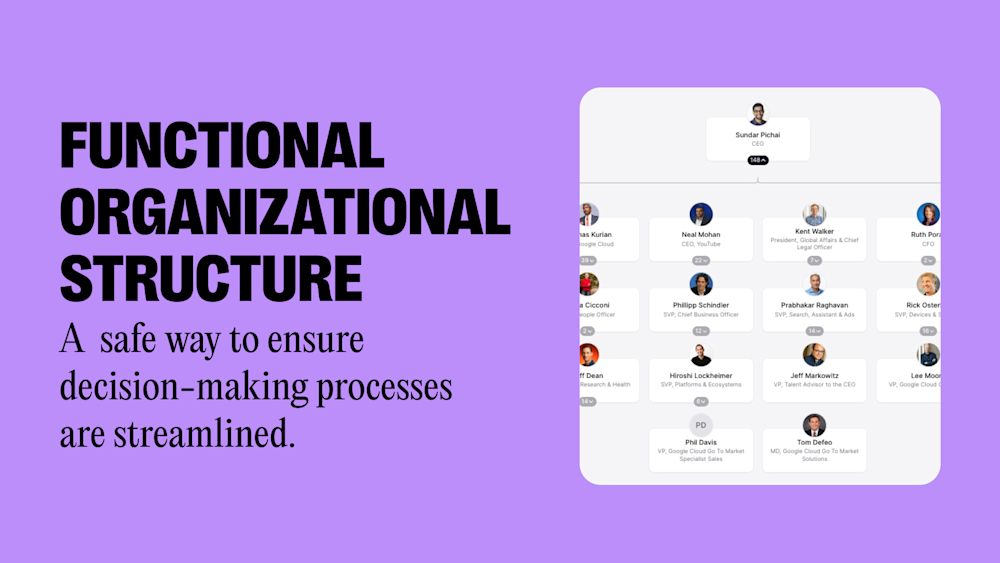Functional Organizational Structure
Table of contents
In this article, we’ll cover what a functional organizational structure is and what characterizes this type of structure. Finally, we’ll explore the pros and cons of the model.

A functional organizational structure is a safe way to ensure that employees are focused and decision-making processes are streamlined. Due to a strict focus on efficiency and a clear chain of command, functional structures are especially popular among larger companies.
Every time an organizational structure has benefits, however, it also has downsides. In this article, we’ll cover what a functional organizational structure is and what characterizes this type of structure. Finally, we’ll explore the pros and cons of the model.
Let’s get into it!
What is a functional organizational structure?
A functional structure is defined as a system where employees are grouped in different departments based on expertise, each having a functional head. Unlike a hierarchical chart, employees are organized by function rather than by authority.
These departments are referred to as “silos”. This term comes from the metaphor of grain silos that are tall, slim, and isolated to each store different types of grain. Similarly, employees in a functional organizational structure are isolated from other departments.
Which characteristics does a functional structure organization have?
There are three main areas where a functional organizational structure is distinctive in its design. These are:
- Departmental specialization
In a functional organization, every department is specialized in a particular field, such as sales, marketing, engineering, or finance.
- Clear hierarchy
Employees within the department report to the department head who reports to the executives.
- Limited cross-collaboration
As employees work in silos, they are entirely focused on their own work and do not work cross-functionally.
Pros and cons of a functional organizational structure
The characteristics of a functional organizational structure can be both good and bad, depending on the needs of the organization. Here are some of the pros and cons of the structure:
Pros
- Clear decision-making process
Because each employee isn’t individually managed, functional organizational designs allow for more flexibility and autonomy within each department, while still keeping an effective chain of command through the head of each department.
- Grouped based on expertise
By strictly working within their field, employees can focus entirely on their own domain of expertise. This can increase efficiency and lead to higher satisfaction since employees don’t have to work in fields they aren’t interested in.
- Easier measurement and development
Because employees are grouped by fields of expertise, it becomes easier to evaluate their performance, as employees can be measured against each other. New skill development also becomes easier since training can be focused on a particular skill set within that field.
Cons
- Internal isolation
Within a functional org structure, there is a risk of professional as well as personal isolation. As employees are grouped by expertise, cross-functional collaboration is not encouraged. This can lead to social issues if teams do not socialize with others.
- Less innovation
Innovation often happens when different perspectives meet to come up with a solution. Functional structures can prevent this creativity from unfolding, as the model discourages employees from cross-functional collaboration.
- Slower decision-making
The chain of command in functional organizational structures goes through the department head further up to the executives. Though the decision-making process in functional structures is clear and well-defined, it is slow when compared to flatter structures.
Who is the functional structure optimal for?
Functional organizational structures are suitable for larger companies that want to keep their employees focused on their specific areas of expertise.
These structures do not prioritize fostering innovation through cross-functional collaboration. Instead, they focus on efficient workflows and a streamlined decision-making process.
Example of a functionally structured organization
A large company that operates with a structure that has functional elements is Unilever, the owner of brands such as Knorr, Dove, and Ben & Jerry’s. In late 2022, Unilever announced changes to its organizational structure to make it “simpler, more category-focused”.
It moved away from its matrix structure and organized into five departments focused on Beauty & Well-Being, Personal Care, Nutrition, Home Care, and Ice Cream. Each department, or Business Group as Unilever calls it, is responsible for its own operations.
This structure has elements of a divisional organizational structure, but also of a functional structure, since the departments each have a specialized focus and operate in isolation from each other.
Learn more about organizational design
Want to learn more about organizational structures? At The Org, we have the world’s largest network of publicly available org charts and a ton of resources that will teach you more about management, organizational design, and how you can make your own org chart.


The ORG helps
you hire great
candidates
Free to use – try today